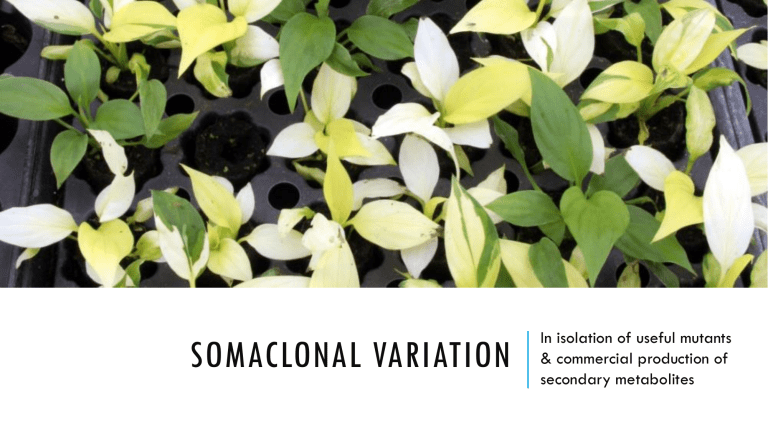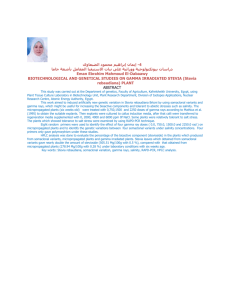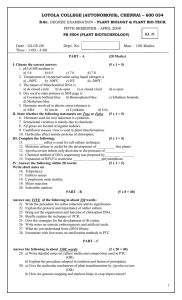Somaclonal Variation: Plant Tissue Culture & Genetic Diversity
advertisement

SOMACLONAL VARIATION In isolation of useful mutants & commercial production of secondary metabolites TOPIC : 6 ANIKA TAHSIN Roll-01 AFSANA AKTER Roll-07 SAIMA MUBASHSHIRA Roll-13 NASRIN AKTER Roll-42 SHAMSUTTIYEBA SHIFA Roll-38 INTRODUCTION ANIKA TAHSIN Roll-01 EXPLOITING THE MODEST Mankind had been modifying microbes, plants, even other animals to obtain desired traits for about 10,000 years. With the evolutionary changes constantly changing the designs of the living, we have obtained the now common food species, characteristically different from their ancestors. Modifications of such have led to advantageous outcomes e.g. increased food production, reliability, and yields; enhanced taste and nutritional value; and decreased losses due to various biotic and abiotic stresses, such as fungal and bacterial pathogens GENETIC MODIFICATION Genetic Engineering Independent Genetic Engineering Dependent • Simple Selection • Microbial Vectors • Interspecies Crossing • Microprojectile Bombardment • Somatic Hybridization • Electroporation • Somaclonal Variation • Microinjection • Mutation Breeding • Transposons/Transposable Elements PRODUCING SUPERIOR TRAITS WITHOUT ENGINEERING Somaclonal variation, a natural phenomenon that can RANDOMLY generate beneficial traits (from human perspective, of course) in plants; a term coined by two Australian scientists Larkin and Scowcroft in 1981 Plants regenerated from tissue culture sometimes had novel features, which they thought, might provide a new source of genetic variability, new variants carrying attributes of value to plant breeders As independent of genetic engineering, it is especially suitable for application in developing countries with limited resources to identify gene sequences HETEROGENEITY ARISING FROM THE HOMOGENEOUS Somaclonal variation is defined as the variability generated through a tissue culture cycle - a process that involves the establishment of a dedifferentiated cell or tissue culture under defined conditions, proliferation for a number of generations In general, plants produced in tissue culture are true-to-type, meaning genetically homogeneous, and have a uniform phenotypic appearance. However, in most cases, a large number of cell cycle results in a genetically heterogeneous population of cells with variable phenotypes. SOMACLONES ARISE THROUGH MOLECULAR ALTERATIONS DURING CELL DIVISION CYCLES IN TISSUE CULTURE DISTINCT DISTINCT DISTINCT DISTINCT DISTINCT DISTINCT HETEROGENEITY ARISING FROM THE HOMOGENEOUS This heterogeneity is majorly due to either, Expression of chromosomal mosaicism in cells of explants, or Alterations resulting from culture conditions through spontaneous mutations The resulting variation is attributed to (heritable) changes in • Chromosome number (e.g. aneuploidy, polyploidy) or structural rearrangements • Nucleotide base sequence or copy number of a given gene • Activation and transposition of transposable elements and • Stable (non-heritable) changes in gene expression MOSAICISM REFERS TO THE PRESENCE OF TWO OR MORE POPULATIONS OF CELLS WITH DIFFERENT GENOTYPES IN ONE INDIVIDUAL WHO HAS DEVELOPED FROM A SINGLE FERTILIZED EGG. GENERATING NOVEL FEATURES Despite being considered an undesirable consequence in plant tissue culture; as we continue to limit chance of variability in the available germplasm and gene pool by exhausting intense breeding and selection; somaclonal variation has proven to be effective regardless, in generating novel features. This process also provides higher mutation frequencies over spontaneous variation for genetic improvement. HANDLING PLANTS LIKE MICROBES! Somaclonal variation has a remarkable potential to screen mutants in vitro, and identification of mutants with novel characteristics Protoplast, cell suspension and callus cultures are handled like microorganisms to search for biochemical mutants ‘Selection agents’ (e.g. herbicide) are used for successful isolation and detection of desired trait (e.g. herbicide resistant) Figure: Generation of herbicide-resistance in plants using somaclonal variation THE RED FLASH Caladium (Caladium x hortulanum Birdsey), an ornamental plant with dramatic leaves, which come in many different shapes, colors, and variegation patterns. Reports indicated that somatic variation was common in caladium and variations include changes in leaf shape, apex, base and margin, color of lamina, spotting, veins, and petiole attachment and color. Figure: Leaf morphology of the wildtype (WT) and ten somaclonal variant types (SVT) of ‘Red Flash’ caladium. These somaclonal variants exhibited considerable changes in leaf shape, coloring of the main veins, spots, margins, and leaf size, and could be separated into 10 somaclonal variant groups. For the wildtype and each SVT, the photo of the leaf was taken from: SVT1 from Plant M2, SVT2 from Plant M1, SVT3 from Plant M5, SVT4 from Plant M36, SVT5 from Plant M187, SVT6 from Plant M45, SVT7 from Plant M75, SVT8 from Plant M7, SVT9 from Plant M4, and SVT10 from Plant M203. Scale bar 3 cm. Reference: Somaclonal variation in ‘Red Flash’ caladium: morphological, cytological and molecular characterization, Cao et. al, Plant Cell Tiss Organ Cult (2016) 126:269–279 VARIEGATION IS THE APPEARANCE OF DIFFERENTLY COLOURED ZONES IN THE LEAVES AND SOMETIMES THE STEMS, OF PLANTS. THE RED FLASH Results from this particular study (Cao & Sui, 2016) showed that the type of leaf explants and auxin affected the occurrence of somaclonal variation in ‘Red Flash’. The highest percentage of variants (25%) was observed among plants regenerated from mature leaf explants cultured on the media containing 2,4-dichlorophenoxyacetic acid. Twelve variants contained 1.1–5.4 % less nuclear DNA and appeared to have lost one chromosome. Two variants contained 5.4–9.2 % less nuclear DNA and appeared to have lost two chromosomes. One variant contained 95.0 % more nuclear DNA and 2n = 58 chromosomes (aneuploid) Figure: Micrographs of somatic chromosomes in the root tips of the wildtype and five somaclonal variants (M25, M187, M3, M7, and M4) of ‘Red Flash’ caladium obtained from in vitro cultured young or mature leaf segments. Photographs were taken under a bright field microscope at 1000 magnifications. a M45 (2n = 2x 2 = 28), b M187 (2n = 2x - 1 = 29), c wildtype (2n = 2x = 30), d M3 (2n = 2x = 30), e M7 (2n = 2x = 30), and f M4 (2n = 4x - 2 = 58). Scale bars 10 μm. Reference: Somaclonal variation in ‘Red Flash’ caladium: morphological, cytological and molecular characterization, Cao et. al, Plant Cell Tiss Organ Cult (2016) 126:269–279 ROSE-SCENTED GERANIUM Pelargonium graveolens produced rose scents are most commercially important in the perfume industry and are cultivated and distilled for their scents. Pelargonium distillates and absolutes, commonly known as "scented geranium oil" are sometimes used to supplement or adulterate expensive rose oils. ‘Velvet Rose’ is an improved scented Geranium variety which has been developed through somaclonal variation (2002). THORNLESS BLACKBERRY An example of heritable somaclonal variation is the development of pure thornless blackberries Lincoln Logan (Rubus). A tissue culture-derived bramble cultivar, ‘Lincoln Logan’ were developed by separating the histogenic layers of chimeral ‘Thornless Logan’ to form a pure thornless type (Hall et al., 1986) This ‘Everthornless’ is a genetically pure form of ‘Thornless Evergreen’ that was obtained via somaclonal variation (McPheeters and Skirvin, 1995; Plant Patent No. 9407) ISOLATION AND DETECTION AFSANA AKTER Roll-07 ISOLATION OF SOMACLONAL VARIANTS In general, two schemes are followed in isolation of somaclonal variants: 1. Without in vitro Selection (plant level) 2. With in vitro Selection (cellular level) WITHOUT IN VITRO SELECTION 1 Unorganized callus and cells, grown in non-selective culture for various periods on a medium, are induced to differentiate 2 Explant (leaf, stem, root etc) is cultured on a suitable medium, supplemented with growth regulators 3 These cultures are normally sub-cultured, and transferred to shoot induction medium for regeneration of plants 4 5 So produced plants are in pots, transferred to field • Newly generated plants are analyzed for subclonal variation WITHOUT IN VITRO SELECTION Limitations: Lack of specificity for isolation of somaclones The appearance of a desired trait is purely by chance Time consuming and require screening of many plants WITH IN VITRO SELECTION In this approach, variant of a particular character are selected at cellular level, rather than the general variation obtained in the first case. Protoplast, cell suspension and callus cultures are handled like microorganisms to search for biochemical mutants WITH IN VITRO SELECTION 1 Dediffentiated culture is subjected to selection against inhibitors like antibiotics, amino acid analogs, pathotoxins etc 2 The compounds are in optimal concentrations in the medium, such that some cell population survives and can be further grown on a selective medium. 3 Selection cycles are carried out to isolate the tolerant callus cultures and these cali are regenerated into plants. 4 The plants so obtained are in vivo screened against the toxin (or pathogen or any other inhibitor) 5 The plants resistant to the toxin are selected and grown further by vegetative propagation or self-pollination 6 The subsequent generations are analyzed for resistant plants against the specific inhibitory substance WITH IN VITRO SELECTION WITH IN VITRO SELECTION Advantages: Specific selection for isolating a desired trait Procedure is less time consuming as compared to without in vitro approach DETECTION OF SOMACLONAL VARIANTS Detection is carried out by the following schemes: 1. Analysis of morphological characters: Qualitative character: plant height, maturity date, flowering date and leaf size. Quantitative character: yield of flower, seed and wax contents in different plant parts 2. Variant detection by cytological studies: Staining of meristematic tissues like root tip, leaf tip with feulgen and acetocarmine provide the number and morphology of chromosomes. 3. Variant detection by gel electrophoresis: Change in concentration of enzymes, proteins and chemical products like pigments, alkaloids. FACTORS INFLUENCING VARIATION When attempting to produce somaclones for a new crop plant, some factors that are valid for both the schemes must be considered. Selection propagule (cells, protoplasts, calli) Genotype and explant source There is a greater potential for mutation in shoots regenerated adventitiously compared to axillary shoot regeneration FACTORS INFLUENCING VARIATION Selection agent (toxin, herbicide, amino acid analogue) Technique used for selection. Duration of cell culture In general, the frequency of mutation increases with the age of the tissue cultures Growth hormone effects Stability of resistant substance SECONDARY METABOLITE PRODUCTION SAIMA MUBASHSHIRA Roll-13 SECONDARY METABOLITES Secondary metabolites are chemicals produced by plants for which no role has yet been found in growth, photosynthesis, reproduction, or other "primary" functions. Unlike primary metabolites, absence of secondary metabolites does not result in immediate death, but rather in long-term impairment of the organism's survivability, fecundity or aesthetics, or perhaps in no significant change at all. Often play an important role in plant defense against herbivory and other interspecies defenses. COMMERCIAL APPLICATION OF SECONDARY METABOLITES Analgesic medicine (codeine, morphine) Muscle relaxant (atropine) Pharmaceutical Industry Antifertility drug (diosgenine) Anticancer drug (taxol, vincristine) Antimalarial drug (quinine) CRITERIA OF A SOMACLONAL VARIANT To be of commercial use, a somaclonal variant must fulfill certain basic requirements: 1. It must involve useful characters. 2. It should be superior to the parents in the character(s) in which improvement is sought. 3. The improved character(s) must be combined with all other desirable characters of the parent. 4. The variations must be inherited stably through successive generations by chosen means of propagation. TURMERIC : ONE OF THE MAJOR APPLICATION Turmeric (Curcuma longa L.), known as the ‘Golden Spice’, is one of the most important ancient spices and a customary item for export. It has been used as a medicinal plant, is reported to be a therapeutic agent for several major human diseases. The primary biological active constituent of turmeric is the curcumin, a secondary metabolite polyphenol that has potent anti-inflammatory and anti-oxidant properties. In turmeric, natural genetic variation is less due to vegetative propagation and lack of sexual cycle. Hence, the present investigation aims at the isolation of high yielding somaclonal variants through callus phase in turmeric variety Suguna. EVALUATION OF SOMACLONES BASED ON MORPHOLOGICAL TRAITS In a notable study conducted by Roopadarshini and Gayatri (2012) the somaclones isolated as V1 generation (first generation following the in vitro phase) were hardened and transferred to the field to study their morphological traits 1. Plant height, 2. Number of tillers per clump, 3. Number of leaves per clump, 4. Leaf size, 5. Yield of rhizomes per clump and dry recovery This traits compared with the normal regenerants and control (variety Suguna) EVALUATION OF SOMACLONES BASED ON MORPHOLOGICAL TRAITS v The somaclone “Narrow elongated leaf with thick short pseudostem” (SC1) was found to be superior with regard to plant height (110.42 cm) and rhizome yield (538.87 g) when compared to the other somaclones, normal regenerants and the control plant. Reference: Isolation of Somaclonal Variants for Morphological and Biochemical Traits in Curcuma longa (Turmeric); Roopadarshini, V* and Gayatri, MC; Research in Plant Biology (2012), 2(3): 31-37 EVALUATION OF SOMACLONES BASED ON BIOCHEMICAL TRAITS The somaclone “Narrow elongated leaf with thick short pseudostem” (SC1) was found to be superior with regard to biochemical traits, with high curcumin (5.48%), oleoresin (15.23%) and volatile oil (7.16%) contents when compared to other somaclones, normal regenerants and the control plant. It was observed that there exist highly significant differences with regard to morphological and biochemical traits among the somaclones. Reference: Isolation of Somaclonal Variants for Morphological and Biochemical Traits in Curcuma longa (Turmeric); Roopadarshini, V* and Gayatri, MC; Research in Plant Biology (2012), 2(3): 31-37 SECONDARY METABOLITE PRODUCTION NASRIN AKTER Roll-42 PATCHOULI : A SOURCE OF ESSENTIAL OIL Patchouli, a medium-sized aromatic shrub, is grown mainly in Indonesia, Malaysia, China, and Brazil for its essential oil. Pogostemon patchouli whose essential oil is highly valued in perfumery, is exclusively vegetatively propagated for the absence of flowering and seed set. Absence of generation of genetic variability through sexual reproduction in patchouli has resulted in its restricted adaptability. Since patchouli has been propagated only vegetatively for more than 50 year, it is expected that it may have accumulated a large number of mutations either in homozygous or heterozygous conditions which may have remained phenotypically unexpressed in single or a few cells. Somaclonal variation could thus be expected to release this hidden and unexpressed variability. EVALUATION OF SOMACLONAL VARIATION In an eminent study conducted by Seshagirirao et. al, 2012; 40 randomly selected somaclones were employed for evaluating somaclonal variation. These plants were multiplied vegetatively through their stem cuttings along with their parental variety Johore and evaluated in SC2 and SC3 generations (second and third vegetative generation, respectively, after the in vitro phase). Plant height and herb yield were recorded at harvest after 4 momths of planting. The harvested herb was shade-dried for 3 days and the essential oil content in the shadedried herb was estimated. The essential oil composition with respect to the seven constituent, these are βpatchoulene, β-caryophyllene, α-guaiene, seychellene, α,δ-patchoulene, α-bulnesene, and patchouli alcohol, was determined by gas chromatography (GC). COMPARISON AMONG DIFFERENT TRAITS Significant variation was observed among somaclones for plant height, herb yield, essential oil yield, and contents of patchouli alcohol, α-guaiene, α ,δ-patchoulene, and α-bulnesene in the essential oil. Reference: Evaluation of somaclonal variation for genetic improvement of Patchouli (Pogostemon patchouli), an exclusively vegetatively propagated aromatic plant; Seshagirirao et. al, J. Crop Sci. Biotech. (2012); 15 (1) : 33-39 INTER-TRAIT CORRELATIONS Essential oil yield was positively correlated with plant height, herb yield, and essential oil content, with a higher correlation between herb yield and essential oil yield than others. Correlations between essential oil content and plant height or herb yield were positive but relatively low. The correlations between patchouli alcohol content in the essential oil and plant height, herb yield, and essential oil content were intermediate and negative. Reference: Evaluation of somaclonal variation for genetic improvement of Patchouli (Pogostemon patchouli), an exclusively vegetatively propagated aromatic plant; Seshagirirao et. al, J. Crop Sci. Biotech. (2012); 15 (1) : 33-39 PROSPECTS AND LIMITATIONS SHAMSUTTIYEBA SHIFA Roll-38 LIMITATIONS OF SOMACLONAL VARIATION Despite several applications of somaclonal variations, there are certain limitations/ disadvantages: i. Most of the somaclonal variations may not be useful. ii. The variations occur in an unpredictable and uncontrolled manner. iii. Many a times the genetic traits obtained by somaclonal variations are not stable and heritable. LIMITATIONS OF SOMACLONAL VARIATION iv. Somaclonal variations are cultivar-dependent which is frequently a time consuming process. v. Somaclones can be produced in only those species which regenerate to complete plants. vi. Many cell lines (calli) may not exhibit regeneration potential. CONFUSED?




